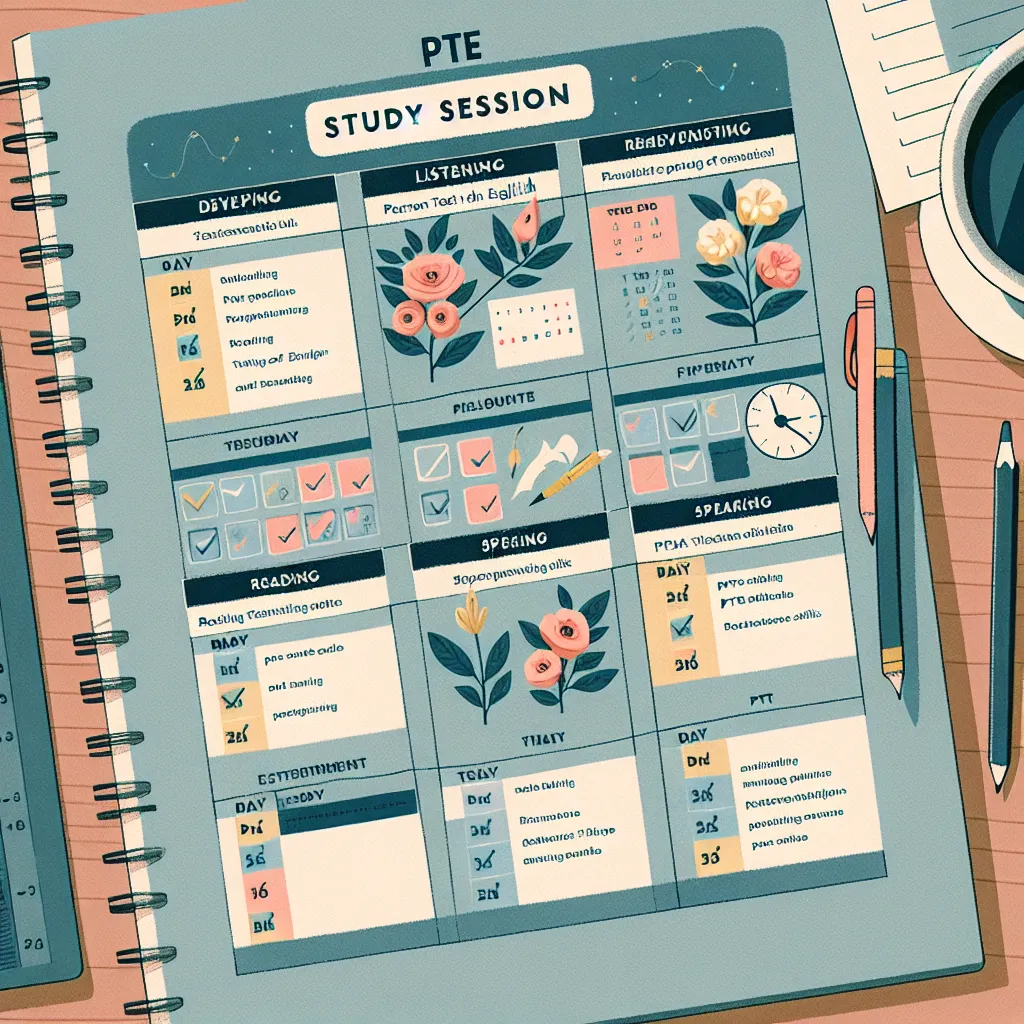Are you preparing for the Pearson Test of English (PTE) and wondering how to organize your study time effectively? Creating a well-structured study schedule is crucial for maximizing your preparation and achieving your desired score. In this comprehensive guide, we’ll walk you through the process of structuring an effective study schedule for PTE, ensuring you cover all aspects of the exam and make the most of your study time.
Understanding the Importance of a Structured Study Schedule
Before diving into the specifics of creating a study schedule, it’s essential to understand why having a structured approach is vital for PTE success. A well-planned schedule helps you:
- Cover all exam sections systematically
- Allocate appropriate time to each skill
- Maintain consistency in your preparation
- Track your progress and identify areas for improvement
- Reduce stress and anxiety associated with exam preparation
 PTE study schedule planner
PTE study schedule planner
Assessing Your Current Level and Setting Goals
Evaluate Your Starting Point
Before creating your study schedule, it’s crucial to assess your current English proficiency level. Take a PTE mock test or diagnostic test to identify your strengths and weaknesses in each exam section. This evaluation will help you allocate more time to areas that need improvement.
Set Realistic Goals
Based on your assessment, set specific, measurable, achievable, relevant, and time-bound (SMART) goals for your PTE preparation. For example:
- “Improve my speaking score from 65 to 75 within two months”
- “Complete 500 reading practice questions in four weeks”
- “Achieve an overall score of 79+ in three months”
Creating Your PTE Study Schedule
1. Determine Your Available Study Time
Calculate how many hours per week you can dedicate to PTE preparation. Consider your work, school, or other commitments. Be realistic to ensure you can stick to your schedule.
2. Allocate Time for Each Exam Section
Divide your study time among the four main PTE sections:
- Speaking and Writing (54-67 minutes in the actual test)
- Reading (32-41 minutes in the actual test)
- Listening (45-57 minutes in the actual test)
Allocate more time to sections where you need the most improvement, but ensure you’re practicing all skills regularly.
3. Plan Your Weekly Schedule
Create a weekly timetable that includes:
- Daily study sessions (e.g., 1-2 hours on weekdays, 3-4 hours on weekends)
- Specific tasks for each session (e.g., “Practice 10 Describe Image questions” or “Complete one Reading Fill in the Blanks passage”)
- Regular breaks to maintain focus and prevent burnout
 Weekly PTE study schedule template
Weekly PTE study schedule template
4. Incorporate Various Study Materials
Include a mix of study materials in your schedule:
- Official PTE practice tests
- PTE preparation books and online resources
- Vocabulary and grammar exercises
- English language immersion activities (e.g., watching English news, podcasts)
5. Allow Time for Review and Mock Tests
Set aside time each week to review your progress and take full-length mock tests. This will help you:
- Track your improvement
- Identify areas that still need work
- Build test-taking stamina
- Familiarize yourself with the exam format and timing
Tips for Sticking to Your PTE Study Schedule
- Be consistent: Try to study at the same times each day to establish a routine.
- Stay accountable: Share your schedule with a study partner or mentor who can check in on your progress.
- Use productivity techniques: Implement methods like the Pomodoro Technique (25 minutes of focused study followed by a 5-minute break) to maintain concentration.
- Reward yourself: Set small rewards for achieving daily or weekly study goals to stay motivated.
- Be flexible: If you miss a session, don’t get discouraged. Adjust your schedule and make up the time later.
Adapting Your Schedule as You Progress
As you advance in your PTE preparation, regularly reassess your progress and adjust your study schedule accordingly. You may find that you need to:
- Increase time spent on challenging areas
- Reduce focus on sections where you’ve shown significant improvement
- Incorporate more full-length practice tests as your exam date approaches
Remember, a well-structured study schedule is a powerful tool in your PTE preparation arsenal. By following these guidelines and remaining committed to your plan, you’ll be well on your way to achieving your desired PTE score.
Conclusion
Structuring an effective study schedule for PTE is a crucial step in your exam preparation journey. By assessing your needs, setting clear goals, and following a consistent study plan, you’ll maximize your chances of success. Remember to stay flexible, track your progress, and adjust your schedule as needed. With dedication and a well-organized approach, you’ll be well-prepared to tackle the PTE exam with confidence.
We’d love to hear about your PTE study experiences! Share your tips or questions in the comments below, and don’t forget to check out our other articles on PTE preparation strategies for more valuable insights.
[internal_links]




